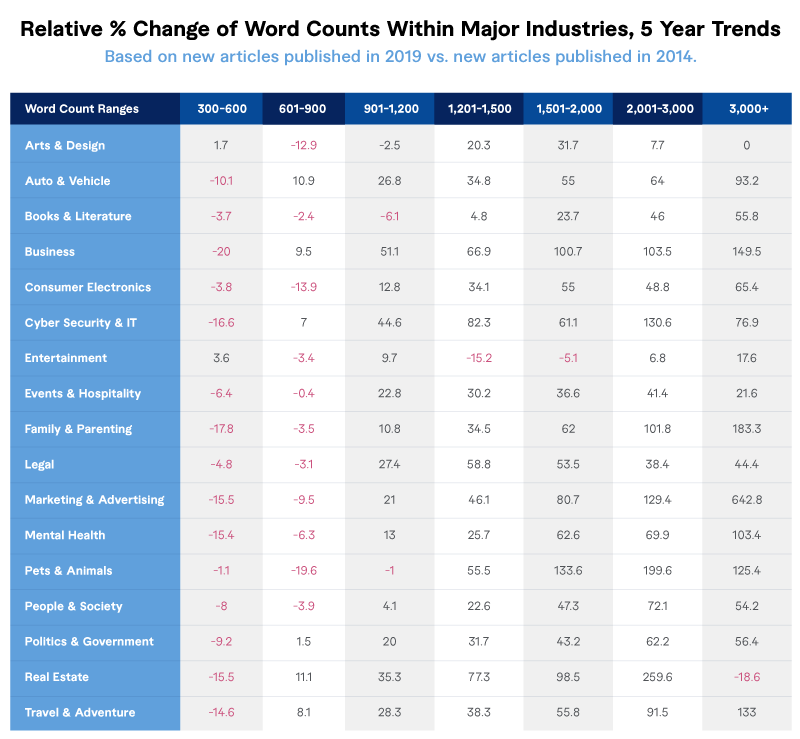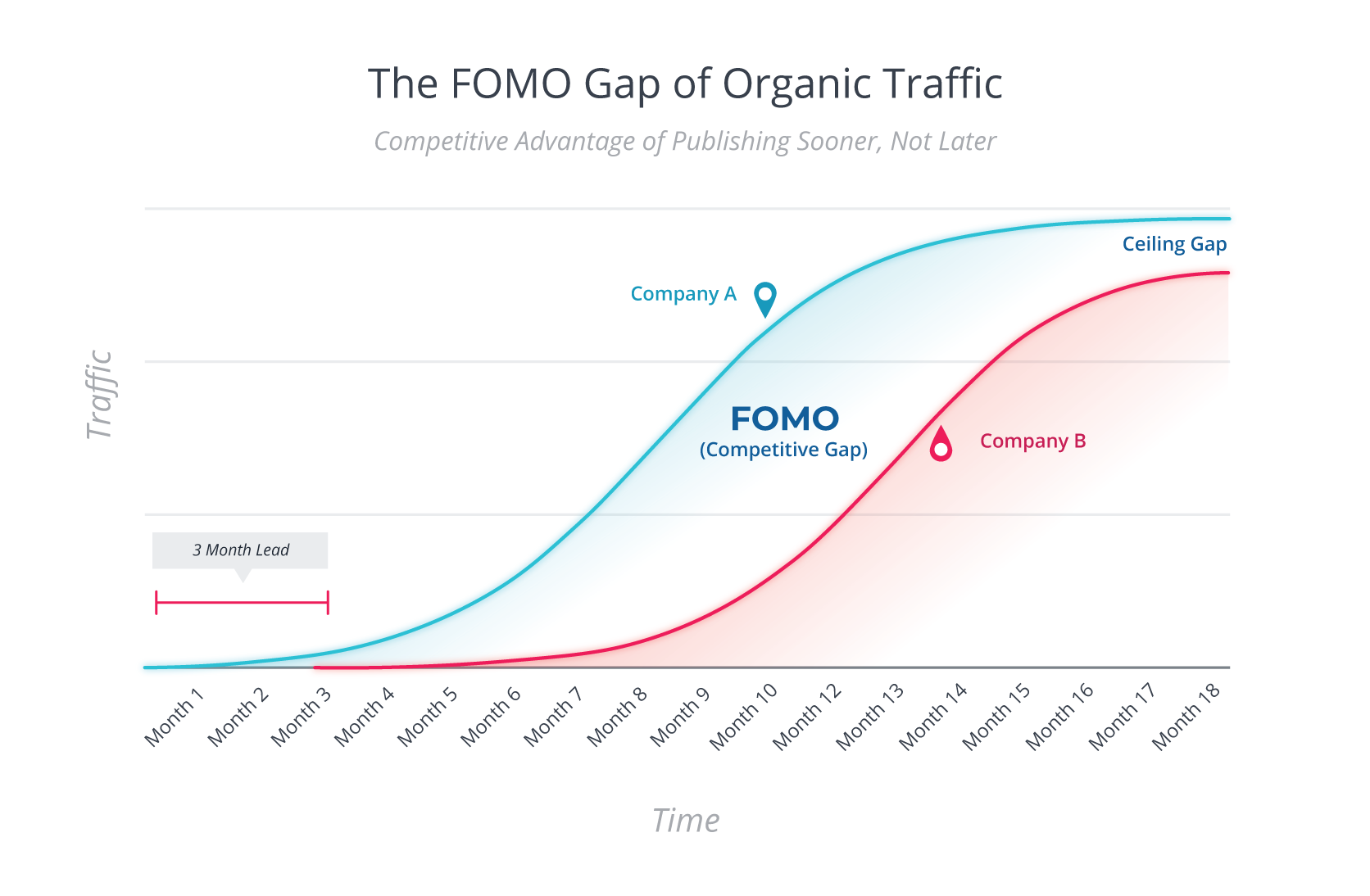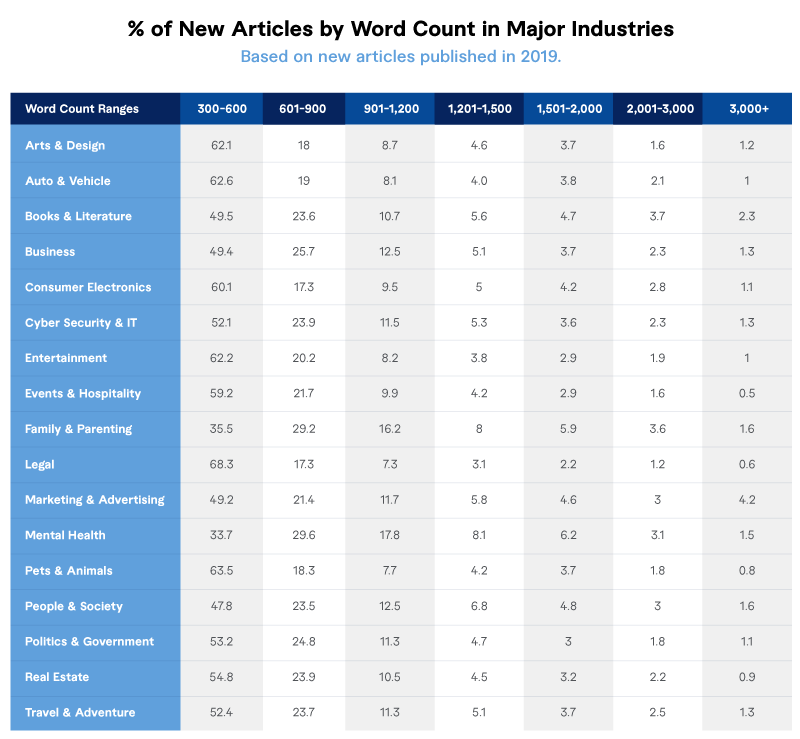What can you learn from ~25 million bylined articles? A lot. We’re connecting the dots between two massive data studies so you can apply word count trends in your industry to adjust your content strategy accordingly.
In December 2019, our colleagues at SEMrush published a study on “The Anatomy of Top Performing Articles.” And after they analyzed the engagement rates on 700,000+ articles on a series of factors, one set of their key takeaways centered on article length.
Without a doubt, SEMrush found longer articles perform better.
When compared to articles of average length (901-1200 words), articles with 3,000+ words get:
- 3x more traffic
- 4x more social shares
- 3.5x more backlinks
When compared to short articles (300-600 words), articles with 3,000+ words get:
- 6.4x more traffic
- 4.5x more social shares
- 5x more backlinks

Our own analysis lines up with their findings as well.
Even our own analysis of articles in the ClearVoice Blog (2019) backed up the trend that longer articles perform better, especially for organic search traffic. While the top 10% of ClearVoice articles in terms of earned organic search visits averaged 1,834 words in length, the bottom 10% of ClearVoice articles in terms of earned organic search visits averaged only 821 words in length.
Since our blog analysis in May 2019, we’ve adapted our blog strategy to integrate more long-form content. The results? Today, our top posts average 2,500+ words in length, and our organic search traffic has more than doubled — yet again — year over year.
Article length on its own isn’t the sole reason, but… If your content is already high-quality, and you make more of it, you set your brand up for more traffic via the basic math of increasing the scope of your quality content.
On the flip side, be mindful that making longer content just for the sake of making longer content is never a good strategy if you’re not committed to creating high-quality content in the first place.
So we tapped into our VoiceGraph™ index of 108+ million articles to gauge word count trends across major industries.
At ClearVoice, we use our proprietary VoiceGraph technology to index more than 73,000 publishers daily and to map articles to more than 1,000 topics in 200 business categories. And it’s not just a faceless algorithm left to churn on its own. VoiceGraph uses machine learning — informed by 500,000+ articles self-categorized and tagged by authors themselves on their ClearVoice Portfolios — to provide highly accurate mapping.
Currently, VoiceGraph has indexed more than 108,000,000 articles and categorized them by more than 20 factors, including by publications, bylines, business categories, topics, word counts, social indicators and others. When we discovered SEMrush focused on word counts for a portion of their study, we knew VoiceGraph could add to the story.
So to take it a step further, we tasked VoiceGraph will pulling the same word count ranges used in the SEMrush study. To look for any word count trends, we mapped more than 24,600,000+ articles, posted 2014-2019, for 25+ top industries and sectors. We hope you can connect the VoiceGraph data we found with the findings of SEMrush and apply the complementary insights to your own content strategy.
[Note to mobile users: You can tap and horizontally scroll the tables if they are not fully responsive on your device.]
Notable findings: We chuckled when we saw the Marketing & Advertising and Books & Literature had the highest industry percentage of articles with 3,000+ words. While the former might already be on to the traffic bonanza of long-form content, the latter might just lend itself to longer content because writers writing about writing — well, it’s a perfect storm of wordiness.

Notable findings: The overall trend toward longer content was clear as can be. Nearly every industry or sector decreased production of the shortest articles (300-600 words) and increased their production of long-form articles (over 1,500 words).
Download our VoiceGraph data studies in more major industries:
- Beauty — 169,000+ Articles
- Education — 228,000+ Articles
- Finance — 2,200,000+ Articles
- Fitness — 184,000+ Articles
- Food and Beverage — 630,000+ Articles
- Health — 2,000,000+ Articles
- Home and Garden — 200,000+ Articles
- Retail — 171,000+ Articles
- Software and Tech — 1,600,000+ Articles
Remember the qualitative benefits of long-form content.
As previously noted, making longer content just for the sake of longer content isn’t a guarantee of better traffic. Although multiple studies beyond the ones mentioned in this post also support the engagement benefits of longer content, you should remember the three key qualitative benefits of longer-form content that underly its success.
- Credible. When it comes to organic search, Google’s E-A-T guidelines for scoring content reward content with higher expertise, authority and trust. Long-form content allows you to go more in-depth on a topic and better establish your credibility on each of these factors. Readers also innately infer you are more credible when you spend more effort on something — because they infer more effort as having more value.
- Digestible. Writing 3,000 words without any structure or progression isn’t a recipe for success. Long-form content gives you the space to include structured lists, supporting assets, and actionable items that can break up a page into easily scannable sections that be can taken one at a time, or easily returned to later. Your structure also can open your content to more audiences by allowing each individual to self-navigate to portions of the content most apropos to their interest or need.
- Educational. While shorter content might get to the point quickly, there are countless topics where the informational or story arc requires far more attention. Long-form content presented in a logical fashion can carry the reader through the three main stages of learning: awareness, comprehension, and practice. And by paying more attention and detail to the nuances of a topic in each stage, you can convey more value to the reader.
And mind the FOMO Gap.
The long-form space is still growing. Although long-form articles still represent a small overall percentage of articles in most industries, there are definitely indications that your competitors might have caught on already, as there is a growing trend from shorter to longer content in most industries. Fortunately, the long-form space is still not saturated.
So mind the FOMO gap. Without a doubt, longer-form content performs better. But the fear of missing out (FOMO) on organic traffic is real. The longer you wait to create content, the more traffic you might lose to your competitors. Even short lead times in publishing can lead to long-term traffic advantages, especially if you win the audience share first — and keep on top.

Use your words wisely with more great topics on ClearVoice:
- Google E-A-T: Why Bylines Should Move Up on Your Priority List
- How to Make a Style Guide That’s Freelancer-Friendly [Templates]
- What Is Teamlancing? The Future of Content Marketing [Ebook]
- The Ultimate Guide to Content Creation [Ebook]




